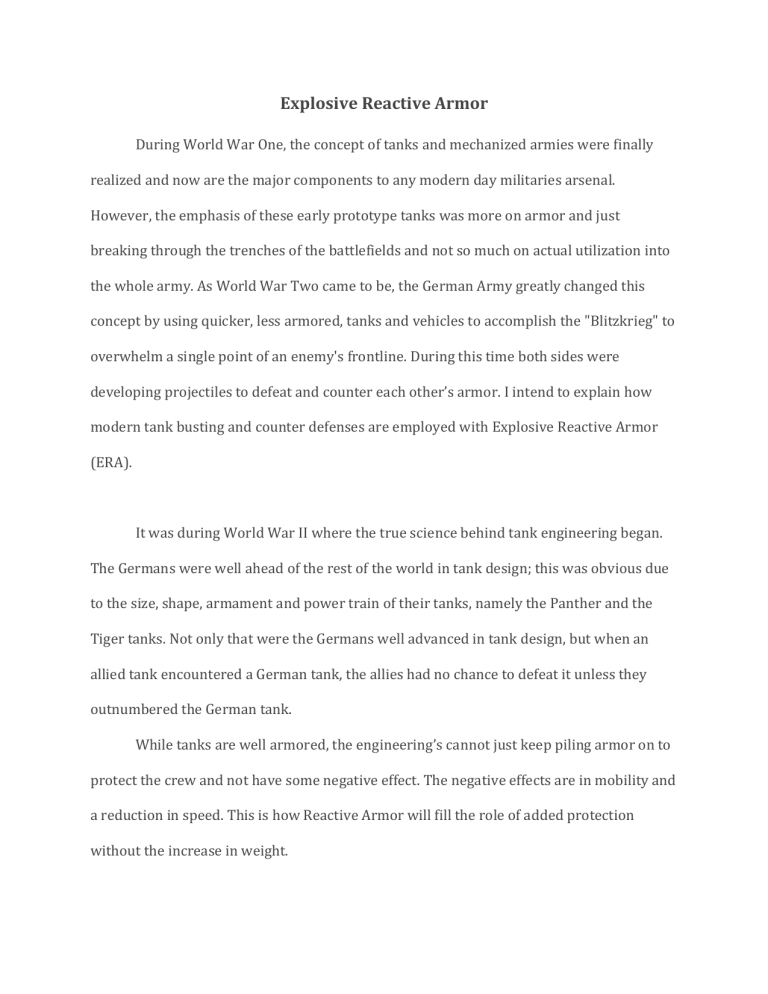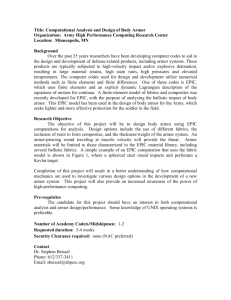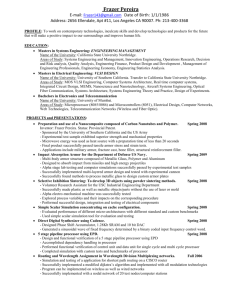ERA

Explosive Reactive Armor
During World War One, the concept of tanks and mechanized armies were finally realized and now are the major components to any modern day militaries arsenal.
However, the emphasis of these early prototype tanks was more on armor and just breaking through the trenches of the battlefields and not so much on actual utilization into the whole army. As World War Two came to be, the German Army greatly changed this concept by using quicker, less armored, tanks and vehicles to accomplish the "Blitzkrieg" to overwhelm a single point of an enemy's frontline. During this time both sides were developing projectiles to defeat and counter each other’s armor. I intend to explain how modern tank busting and counter defenses are employed with Explosive Reactive Armor
(ERA).
It was during World War II where the true science behind tank engineering began.
The Germans were well ahead of the rest of the world in tank design; this was obvious due to the size, shape, armament and power train of their tanks, namely the Panther and the
Tiger tanks. Not only that were the Germans well advanced in tank design, but when an allied tank encountered a German tank, the allies had no chance to defeat it unless they outnumbered the German tank.
While tanks are well armored, the engineering’s cannot just keep piling armor on to protect the crew and not have some negative effect. The negative effects are in mobility and a reduction in speed. This is how Reactive Armor will fill the role of added protection without the increase in weight.
The German researcher Manfred Held and his team were working for the Israelis, using old tanks from The Six Day War, to test shape shells. During these tests it was noted that, if the tank still contained live ordinance it would disrupt the shape charge of the test shell. In the 1970's the Israel Defense Forces (IDF) started using reactive armor because it enables an increase in protection against shaped charges without adding a proportional increase in the weight of the armored vehicle. This armor protects the unit from a variety of anti-tank shells such as; Anti-Tank Guided Missiles (ATGM), High Explosive Anti-Tank (HEAT),
Kinetic Energy Penetrator (KE) and High Explosive Squash Head (HESH).
Types of Anti-Tank Projectiles and Penetrating Mechanisms:
Anti-Tank Guided Missile (ATGM) – This projectile works by firing a missile from some undisclosed place and guiding it either optically or with a laser, exploding on impact. This particular projectile typically contains a tandem warhead to counter
Explosive Reactive Armor. As the first warhead makes contact with the ERA, detonating the explosive reactive armor, and allowing for the next warhead to punch though the vehicles armor.
Source: http://www.army-technology.com/projects/tow/images/tow6.jpg
High Explosive Anti-Tank (HEAT) – This shell works by focusing super heated plasma in a very small area punching a hole in the armor. However, the depth that the super heated plasma can penetrate is proportional to the diameter of the warhead. The depth it can penetrate is approximately three times the diameter of the cone.
Source: http://www.robinsonlibrary.com/military/artillery/ordnance/apshell.htm
Kinetic Energy Penetrator (KE) – This non-explosive projectile, much like a bullet, uses kinetic energy to penetrate the target. This projectile is usually a long thin rod made of a dense and strong material, such as tungsten carbide. However, in order to properly deploy this projectile, a massive gun must be used to provide the maximum velocity and energy to allow the rod to penetrate.
Source: http://www.robinsonlibrary.com/military/artillery/ordnance/apshell.htm
High Explosive Squash Head (HESH) – This is a non-penetrating projectile, unlike the previous shells, a HESH uses a shockwave that is created upon impact of the armor. That shockwave is then transferred inside to the crew cabin where small metal fragments are created.
Source: http://www.robinsonlibrary.com/military/artillery/ordnance/apshell.htm
Explosive Reactive Armor (ERA) works in the following ways:
First, an important mechanism for the success of reactive armor is where the reactive armor is placed and the slope in which it is placed on. The slope of the reactive armor is almost as important as the projectile defeating charge contained within. The slope of the reactive unit allows for the shape charge to be slightly deflected causing the reactive armor to move in such a way that the projectile is continuously creating a new contact point.
Once, the projectile comes into contact with the first metal plate and compresses that plate towards the armored fighting vehicle, the projectile then initiates its own charge, which is located on the tip of the shell.
During the time that the penetrating projectile is making contact with the reactive armor, the explosive layer detonates, forcing the two metal plates apart and the projectile away from the armored fighting vehicle.
As the projectile is being repelled by the explosive force, the penetrating mechanism from the projectile becomes less effective since the depth is dynamically increasing with time along with the movement due to slope as discussed above.
It’s the combination of both the slope; which creates deflection and a new contact surface, and the explosive liner; which forces the two plates apart creating greater penetration distance, that allows for the use of reactive armor to be utilized effectively.
There are some drawbacks to using Explosive Reactive Armor. One such drawback is that it can cause damage to surrounding troops and vehicles, from the explosion. Another drawback is that it cannot be used on lightly or lightly armored parts of vehicles. Also, transportation of ERA is dangerous since you are essentially transporting a bomb.
Overall, the deployment of Explosive Reactive Armor has been very beneficial and shows greater promise as newer technologies emerge such as; Non-Explosive Reactive
Armor (NXRA) and Electric Reactive Armor (EA). As militaries discover ways to protect its forces, there are other militaries developing way to defeat the opponents’ forces. It’s a game of armor vs. anti-armor and these two go hand and hand.
Work Cited:
1.
"StateMaster - Encyclopedia: Explosive reactive armor." StateMaster - US Statistics,
State Comparisons. 31 May 2009
<http://www.statemaster.com/encyclopedia/Explosive-reactive-armor>.
2.
"Reactive armour -." Wikipedia, the free encyclopedia. 31 May 2009
<http://en.wikipedia.org/wiki/Reactive_armor>.
3.
"Modern Reactive Armour Applications." Defense Update Defence Industry News
Military Technology Magazine. 31 May 2009 <http://defenseupdate.com/features/du-1-04/reactive-armor.htm>.
4.
"Armor-Piercing Shells." The Robinson Library. 31 May 2009
<http://www.robinsonlibrary.com/military/artillery/ordnance/apshell.htm>.
5.
"The TOW 2B missile features and components diagram. - Image - TOW 2 Heavy
Anti-Tank Missile."Army Technology. 31 May 2009 <http://www.army- technology.com/projects/tow/tow8.html>.
Analysis of Rhetorical Strategy
The purpose of my paper is to inform the audience of Explosive Reactive Armor and how it will work against various types of anti-tank projectiles. I will also discuss several advantages and disadvantages with the application of such armor. The intended audience would be to defense advisors, however, for classroom purposes it will be to an audience of approximately 20-40 year old college students with little or no prior knowledge to this subject. The subject may be of interest and informative to some people. The environment for which this paper will be readily available to view will be on my wiki page. The needs of the audience will not be anything too technical though an understanding of physics would be helpful. I intend to create exigence by giving the audience a very brief history of tank warfare, the variant of anti-tank projectiles and the mechanisms utilized to defeat armor, as well as some background on how and who created Explosive Reactive Armor with some diagrams.






